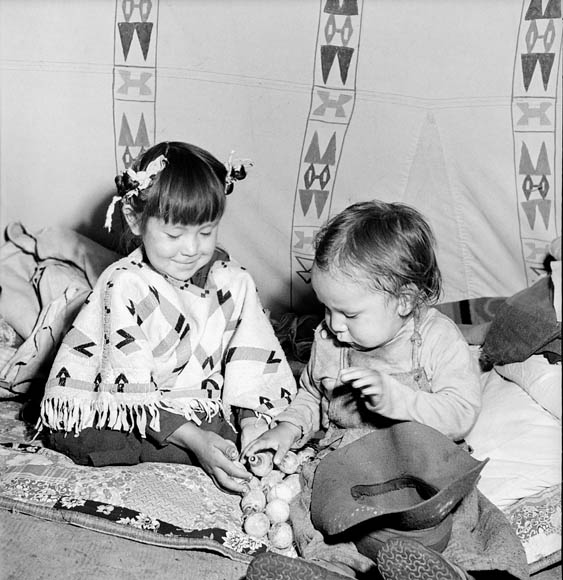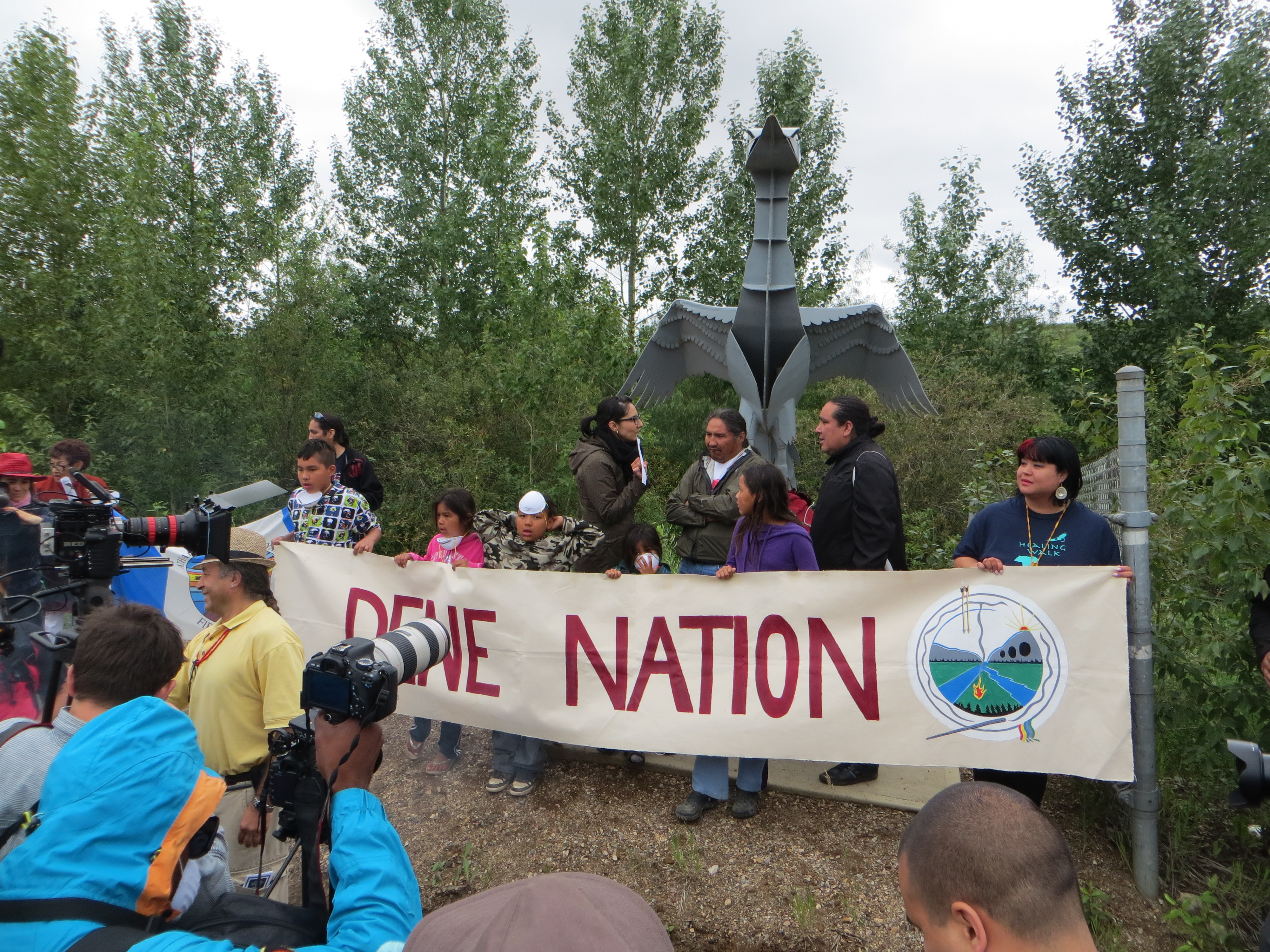The Tsuut’ina (Sarcee) are a Dene (or Athabaskan) First Nation whose reserve borders the southwestern city limits of Calgary, Alberta. The name "Sarcee" is believed to have originated from a Siksikáí’powahsin (Blackfoot language) word meaning boldness and hardiness. The Sarcee people call themselves Tsuut’ina (also Tsuu T'ina and Tsúùt'ínà), translated literally as "many people" or "every one (in the Nation)."

Traditional Territory
According to oral tradition, the Tsuut’ina split from a northern nation, probably the Dane-zaa, and moved to the plains, where they have maintained close contact with the Siksika, Cree and Stoney. Their acculturation to the plains culture distinguishes them from other northern Dene people, but they have retained their language, often known as Sarcee. (See also Plains Indigenous Peoples in Canada.)
Today, Tsuu’tina territory is in southern Alberta, bordering the southwestern city limits of Calgary. In 1877, well-known leader Chief Bull Head reluctantly signed Treaty 7, which created the 280 km2 reserve on which the Tsuut’ina now live.
Traditional Life
Prior to life on the reserve, the Tsuut’ina camped in tipis and hunted along the edge of the forest during the winter. During the summer, all groups met in the open prairie to hunt bison, collect berries and engage in ceremonies, dances and festivals. (See also Buffalo Hunt and Sun Dance.)
When anthropologist Diamond Jenness visited the Tsuut’ina reserve in 1921, the nation consisted of five communities: Big Plumes, Crow Childs, Crow Chiefs, Old Sarcees and Many Horses. Before they were confined to the reserve, each community was led by a Chief. Today, the nation is governed by an elected chief and counsellors. (See also First Nations.)
Language
The Tsuut’ina language (often known as Sarcee) is an Athabaskan/Dene language of northern Canada. (See also Indigenous Languages in Canada.) It is considered endangered; according to the 2021 Statistics Canada census, only 90 people identify Tsuut’ina as their mother tongue. Additionally, only 175 people claimed knowledge of the Tsuut’ina language. Various institutions and community programs are working to preserve and protect the language (see Indigenous Language Revitalization in Canada). In 2011, the University of Calgary developed a program in association with the Tsuu T'ina Gunaha Institute to help revive the language.
Population
From 1857 to 1860, explorer Captain John Palliser estimated the Tsuut’ina population at 1,400 during his scientific expedition of western Canada. Epidemics of smallpox (1837), scarlet fever (1864) and other diseases, as well as wars, reduced their population to 450 by the time they settled on the reserve in 1881. By 1924, the Tsuut’ina population had decreased to about 160.
According to Statistics Canada, between the years 1996 and 2006, the Indigenous population in Canada grew by approximately 45 per cent. This higher growth rate can be contributed to higher birth rates and an increasing tendency for people to identify as Indigenous. As of April 2025, the Tsuut’ina Nation had 2,702 registered members. Of those registered members, 2,260 lived on the Tsuut’ina Nation reserve and 291 lived off-reserve.
History
With colonization and increased white settlement, traditional ways of life for the Tsuut’ina were forever altered. On 22 September 1877, the Tsuut’ina and some other Indigenous nations signed Treaty 7, which created various reserves. At the time, the millions of bison that had once roamed the North American plains — and on which various Indigenous nations relied on for food — had disappeared. For Indigenous peoples like the Tsuut’ina, treaties offered a way to survive; for the Canadian government, treaties were a way of enabling westward settlement and expansion. (See also Numbered Treaties and Reserves in Alberta.)
Like many other Indigenous peoples in Canada, the Tsuut’ina have had their society and culture threatened by colonial policies and practices of assimilation, including the Indian Act, residential schools, reserves and the pass system. These have had historic and ongoing impacts on generations of Indigenous peoples. The final reports of the Truth and Reconciliation Commission and the National Inquiry into Missing and Murdered Indigenous Women speak to ongoing work of reconciliation.
Did You Know?
Chief David Crowchild was a distinguished contemporary leader of the Tsuut’ina (born on 12 April 1899; died on 10 April 1982). Crowchild became Chief in 1946, and established a school and band farm on the reserve.
Culture and Beliefs
Historically, the Tsuut’ina believed in supernatural power that could be obtained through a vision or dream and was enshrined in a tipi painting or medicine object, such as a beaver bundle or pipe bundle. (See also Medicine Bundle.) The quest for supernatural power and the attainment of certain character traits, such as bravery for men and chastity for women, were highly valued. (See also Vision Quest.) In traditional Tsuut’ina culture, the family usually arranged marriages, and the gifts exchanged reflected family status.
In recent years, many Tsuut’ina are Anglican or Catholic, but they observe traditional cultural ceremonies and feasts, such as the Beaver Bundle ceremony and the Medicine Pipe ceremony, the Rock Pile Feast and the Christmas Powwow in the winter. (See also Powwows in Canada.)
The Tsuut’ina also host annual celebrations that include a rodeo, handgames and a golf tournament (see also Dene Games).
Contemporary Life
Today, the Tsuut’ina are active in modern economic sectors, such as cattle raising and real estate, but efforts are being made to revive the traditional culture and lifestyle.
There are also band-operated schools on the reserve which most children attend, while some still go to public or separate schools in Calgary. (See also Education of Indigenous Peoples in Canada.)
In 2020, Costco opened a new store on Tsuut'ina territory. This is the first Costco in North America that is located on a First Nation.

 Share on Facebook
Share on Facebook Share on X
Share on X Share by Email
Share by Email Share on Google Classroom
Share on Google Classroom





